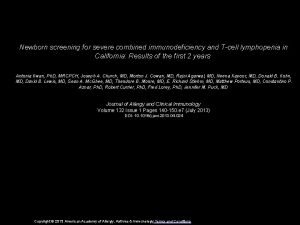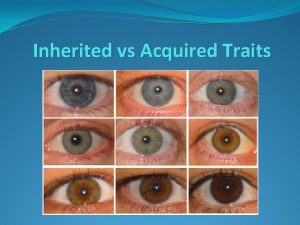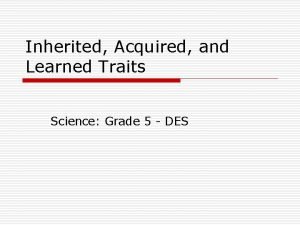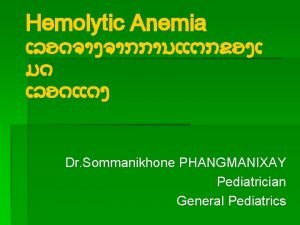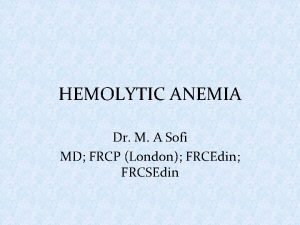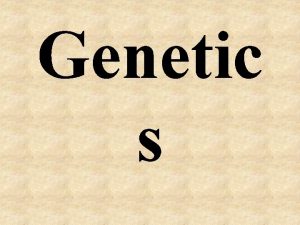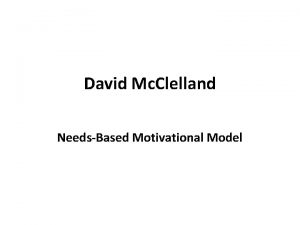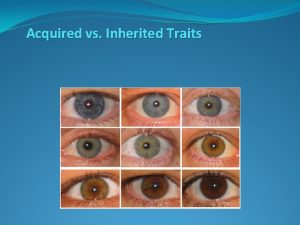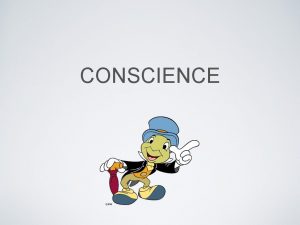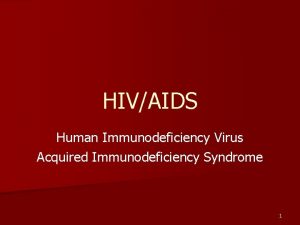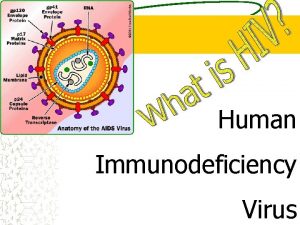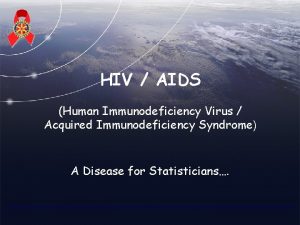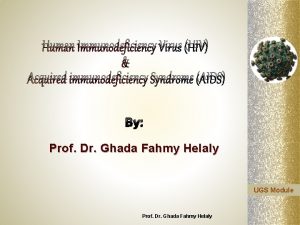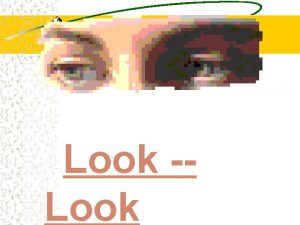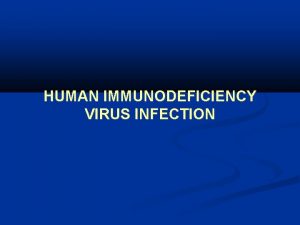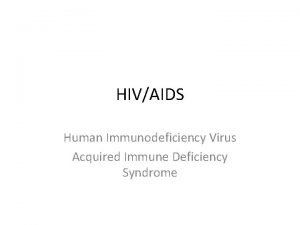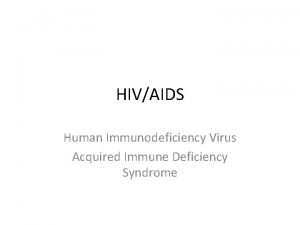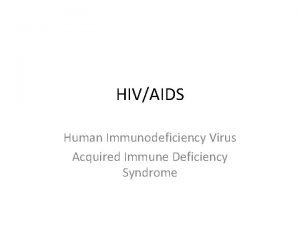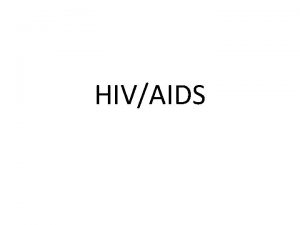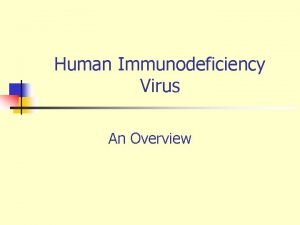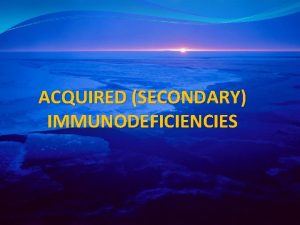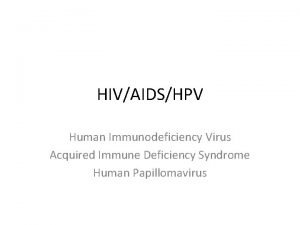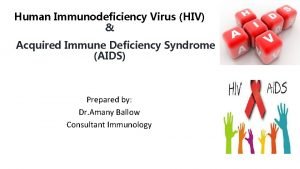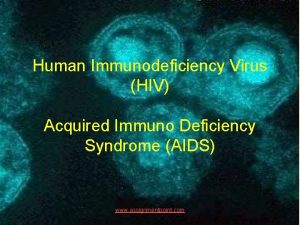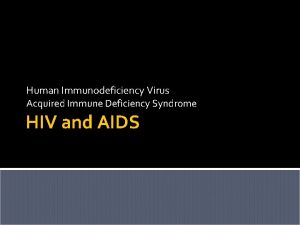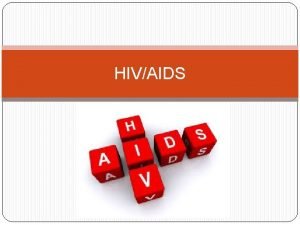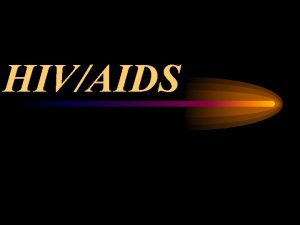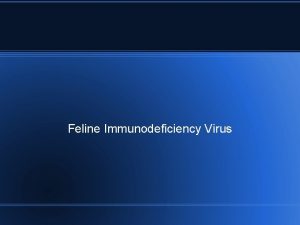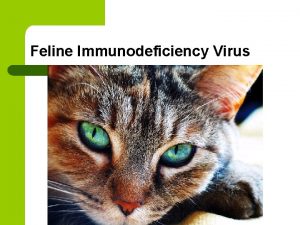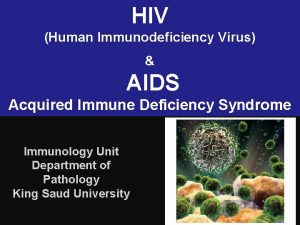HIVAIDS Human Immunodeficiency Virus Acquired Immunodeficiency Syndrome 1


























- Slides: 26

HIV/AIDS Human Immunodeficiency Virus Acquired Immunodeficiency Syndrome 1

AIDS is Caused by HIV n Is the one common denominator within a range of populations. n Has been identified by electron microscopy. n Antibodies, viral antigens, and HIV RNA have been found in HIV-Positive and AIDS patients. n Many others 2

More Origins of HIV Unidentified Flying Objects (UFO’s) coming from space Is a biological weapon designed to kill non-whites. Came from domestic cats. (Feline AIDS is similar to Human AIDS) n HIV Contaminated _______ vaccines. n n n Polio Smallpox Tetanus Hepatitis n n n African Green Monkey African People African Cattle, Pigs, Sheep CIA and other spy agencies Biological Weapons Labs 3

Current Theory Hahn et al. (1999, 2000) n Simian virus closely related to HIV jumped from chimps to humans. n Virus then mutated into its current form. n Evidence n – Genes from all four SIVcpz isolates cluster to their subspecies or origin § Pan Troglodytes - West Africa § Pan Trogldytes Scheinfurthii - East Africa – All known HIV-1 strains cluster with W. Africa Chimp viruses – Evidence of genetic recombination among SIVcpz strains of the Troglodytes lineage. n Newer evidence indicates multiple jumpings – different strains 4

Example n HIV Strains have 11 distinct subtypes – – – n A-K Subtype B is dominant in US and Europe Subtype D is dominant in Africa Virus mutates rapidly. 5

United States HIV History n Virus has been in the US since mid. 1970’s. – 1979 -1981 – Physicians in New York and Los Angeles began reporting particular diseases in Gay males. – Including: § Rare Pneumonias § Cancers § Other diseases – Diseases were not usually found in people with healthy immune systems. 6

1982 n Public Health begins using term Acquired Immunodeficiency Syndrome (AIDS) to describe opportunistic infections in previously healthy men. – Including § Kaposi’s Sarcoma § Pneumocystis Carni Pneumonia n Surveillance of AIDS begins Diagnosis of cellular immune deficiency Absence of an underlying cause Reduced resistance to the disease 7

HIV Surveillance n Definition modified in 1983 n Required to be reported to CDC 8

1983 First cases of AIDS in heterosexuals are documented. n Virus is isolated by various labs. n Named n – HTLV-III (Human T-Lymphotrophic Virus-III) (Gallo) – LAV (Lymphadenopathy Associated Virus) (Luc Montagnier Mont-Tan-Ya) – ARV (AIDS – Related Virus) Ultimately named – HIV (Human Immunodeficiency Virus) (Sub-committee of the Committee on the Taxonomy of Viruses 9

1985 Second type of HIV discovered – HIV-2 § Related to SIV § Not as related to HIV-1 § Does not seem as harmful as HIV-1 § Reproduces slower than HIV-1 n Screening tests become available n Tests of stored blood samples indicate HIV was being transmitted in US and Europe in mid to late 1970’s. n 10

Early Definitions of AIDS 1981 -93 n Many definitions of AIDS n Problem – Social Security Administration (SSA) – Used AIDS definition to determine disability § Symptoms were based on opportunistic infections in men. – Result § 65% of women were excluded § Other problems too 11

1993 n n n New definition of AIDS Emphasized the importance of T 4 lymphocyte counts. Added other diseases System becomes simpler Also allowed one to become diagnosed with AIDS but remain symptom-free of diseases. 12

1987 n First case of HIV-2 in the U. S. n First Anti - HIV drugs become available – Zidovudine (AZT) 13

1988 n Protease Inhibitors are identified. n Have problems with – Absorption – Have rapid liver metabolism – Insolubility n Result – More development and clinical trials. 14

1992 Protease Inhibitors (PI) become more developed n First - Saquinavir Mesylate (Invirase) n – – n Was used in combination with other drugs Minimal clinical trial data Had poor absorption Was the least potent of other PI’s that came on the market later. Second – Ritonavir (Norvir) 15

More Protease Inhibitors are Developed n Saquinavir (Fortovase) n Indinavir (Crixivan) n n n Nelfinavir Amprenavir ABT – 378 (Viracept) (Agenerase) (Kaletra) n Problem – More easily absorbed by the body – Most often used – Drugs are expensive $450 -$700/month – = $5, 400 - $8, 400/yr 16

2000 n Drug Combinations (Cocktails) – Uses multiple combinations of drugs – Called Highly Active Antiretroviral Therapy (HAART) 17

2001 n Negotiations to reduce costs n Generics are developed by outside countries despite patent laws. – Is a major problem n Costs go down n Drug companies reevaluate staying in the HIV drug market n When do you use (early vs. later) 18

Present n HIV continues to mutate – Currently getting HIV resistance to drugs n People are returning to previous lifestyles – Drugs are effective at helping people – Can work – Enjoy life 19

Also People are not taking drug combinations so they effectively block the virus 1. Monotherapy People also stop taking drugs when they do not have money People stop taking drugs when they are feeling better People who are infected are having sex with other infected individuals Has spread into the IDU community which is spreading it into the general heterosexual population. Result 20

1. Drug Resistance n 30% of newly infected individuals have viral forms that resistant to at least one drug. n Drug resistant strains are becoming more powerful n Result – Salvage therapy – Give everything you can – 30 -50% of HIV infected persons are in such therapy. 21

2. New Strains n Are more powerful than previous strains n Cause individuals who are doing well on drug cocktails to become ill again n Has caused us to reevaluate the issues of vaccines n Is going to become a real problem 22

Conclusions and Issues 23

HIV is a Unique Disease n Affects mostly young and middle aged adults. n Are sexually active n Are in their prime productive and reproductive years n Impact is demographic, economic, political, and social. 24

Problem n Have forgotten the past n STD rates are increasing again in some communities n 1999 -2002 number of males with new HIV infections increased 7. 3% (CDC, 2003) – Among MSMs increased 17% 25

HIV Is A Preventable Disease To stop the disease, must change the behavior. n Is a system of numbers. n – More people in a population that have it, – The greater the likelihood YOU (or your offspring) will get it. 1/100 vs. 10/100 vs. 25/100 vs. 50/100 1/10 1/4 1/2 1% 10% 25% 50% 26
 Monocyte derived dendritic cells
Monocyte derived dendritic cells Combined immunodeficiency
Combined immunodeficiency Enoxapan
Enoxapan Acquired thrombophilia
Acquired thrombophilia Far 52-245-1
Far 52-245-1 Original united states date acquired
Original united states date acquired Plants are sessile
Plants are sessile Dog inherited traits examples
Dog inherited traits examples Behavioral trait
Behavioral trait What are 5 acquired traits
What are 5 acquired traits Examples of acquired traits in humans
Examples of acquired traits in humans Acquired physical traits
Acquired physical traits Whats an acquired trait
Whats an acquired trait Inherited and acquired traits
Inherited and acquired traits Systemic acquired resistance in plants
Systemic acquired resistance in plants Acquired hemolytic anemia
Acquired hemolytic anemia Chronic hemolysis
Chronic hemolysis Acquired physical traits
Acquired physical traits What is a biotic factor in an ecosystem
What is a biotic factor in an ecosystem Acquired needs theory
Acquired needs theory Acquired hemolytic anemia
Acquired hemolytic anemia Infer how the pigs acquired another case of whiskey.
Infer how the pigs acquired another case of whiskey. Aquired traits
Aquired traits Are dimples inherited or acquired
Are dimples inherited or acquired Lance brothers enterprises acquired
Lance brothers enterprises acquired New knowledge attitudes and skills acquired in ojt
New knowledge attitudes and skills acquired in ojt Is conscience innate or acquired
Is conscience innate or acquired

